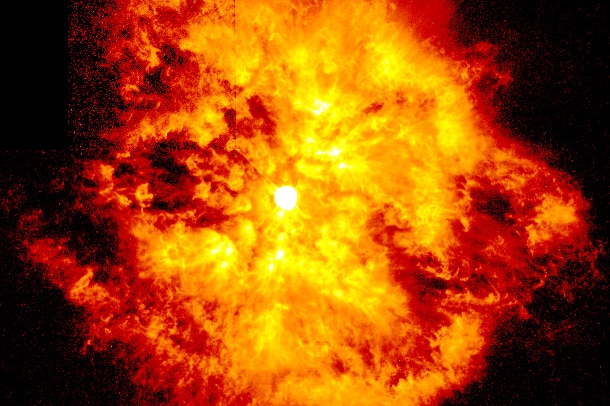| Author | Message |
|---|
 Wiggo Wiggo

Send message
Joined: 24 Jan 00
Posts: 34744
Credit: 261,360,520
RAC: 489


|
Astronomers capture the moment a star explodes at the end of its life.
Astronomers have captured the moment a star, 500 million light years from Earth, exploded in a dramatic supernova, marking the end of its life.
A type II supernova explosion happens when a very large star can no longer fuse atoms within its core, causing it to explode, shedding off its outer layers.
The supernova, named SN2021afdx, happened in the unusually shaped Cartwheel Galaxy, which sits in the Sculptor constellation.
Astronomers captured the image in December 2021 using the European Southern Observatory's New Technology Telescope (NTT) in Chile.
They then compared the image to one of the same galaxy, taken using the Very Large Telescope (VLT) in August 2014 - before the supernova explosion occurred.
A new, bright light can be seen in the lower left hand side of the new image, that isn't visible in the 2014 picture.... I hope that no extinctions happened during the event.
Cheers.
|
|
 Wiggo Wiggo

Send message
Joined: 24 Jan 00
Posts: 34744
Credit: 261,360,520
RAC: 489


|
At 1.4 Million Mph, Astronomers Detected One of The Fastest Cosmic Objects of Its Kind.
When massive stars die, they don't do so quietly.
Their deaths are spectacularly brilliant affairs that light up the cosmos, a supernova explosion that sends star guts punching out into space in a cloud of splendor. Meanwhile, the core of the star-that-was can linger on, collapsed into an ultra-dense neutron star or black hole.
If that explosion takes place in a certain way, it can send the collapsed core barreling across the Milky Way like a bat out of hell, at such insane velocities they can eventually punch clean out of the galaxy altogether, on a wild journey into intergalactic space.
It's one of these objects that has been newly measured via data from the Chandra X-ray observatory: a type of pulsing neutron star known as a pulsar, ripping through its own entrails at a speed of around 612 kilometers per second (or 1.4 million miles per hour).
It's one of the fastest objects of this kind ever detected. (The fastest known star in the Milky Way is not a supernova remnant that has been kicked by an explosion, but a star orbiting Sgr A*, the supermassive black hole in the galactic center. At the fastest point in its orbit, it moves at a wild 24,000 kilometers per second.)..... I would sure hate to be in the way of that.
Cheers.
|
|
 Wiggo Wiggo

Send message
Joined: 24 Jan 00
Posts: 34744
Credit: 261,360,520
RAC: 489


|
James Webb spots its first supernova.
A brilliant light detected by NASA’s James Webb Telescope (JWST) in a galaxy three billion light years from Earth is believed to be the $10 billion scope’s first observation of a dying star exploding.
Formally known as a supernova, it is the ‘last hurrah’ that occurs when the star runs out of fuel. This causes the pressure to drop, in which the cosmic object expands to at least five times the mass of our sun – which is the size of about 333,000 Earths – and then detonates, releasing tons of debris and particles.
The stellar explosion occurred in the galaxy, SDSS.J141930.11+5251593, where JWST snapped images showing the light of an object get dimmer of a span of five days - a clue that sparked the theory of a supernova.
What is additionally exciting is the fact that JWST was not designed to find and detect new transients, Mike Engesser of the Space Telescope Science Institute (STScI), told Inverse that first reported on the discovery.... Cheers.
|
|
 Wiggo Wiggo

Send message
Joined: 24 Jan 00
Posts: 34744
Credit: 261,360,520
RAC: 489


|
|
|
 Wiggo Wiggo

Send message
Joined: 24 Jan 00
Posts: 34744
Credit: 261,360,520
RAC: 489


|
NASA's James Webb Space Telescope captures star on cusp of death.
NASA released the picture on Tuesday at the South by Southwest conference in Austin, Texas.
The observation was among the first made by the JWST after its launch in late 2021.
Its infrared eyes observed all the gas and dust flung into space by a huge, hot star 15,000 light-years away. A light-year is about 9.46 trillion kilometres.
Shimmering in purple like a cherry blossom, the cast-off material once comprised the star's outer layer.
A few decades ago, NASA's Hubble Space Telescope snapped a shot of the same transitioning star, but it appeared more like a fireball without the delicate details.
Scientists say such a transformation occurs only with some stars and, normally, is the last step before they explode, going supernova.
"We've never seen it like that before. It's really exciting," European Space Agency scientist Macarena Garcia Marin, a who is part of the project, said.
This star in the constellation Sagittarius — officially known as WR 124 — is 30 times as massive as our sun and already has shed enough material to account for 10 suns, NASA says. 
Cheers.
|
|
 Wiggo Wiggo

Send message
Joined: 24 Jan 00
Posts: 34744
Credit: 261,360,520
RAC: 489


|
Now here's a twist.
A Supernova Resurrected Itself.
A group of astronomers recently discovered that a far-off supernova isn’t behaving at all like we expected, and it’s teaching us a lot about these massive explosions.
Supernova 2018ivc, as it’s so excitingly called, seems to have resurrected itself almost 3 years after its initial explosion. After spotting the blast a day after it appeared in the sky, researchers originally decided to monitor the supernova and its aftermath for 200 days. When it proved to be both surprisingly dim and quickly evolving, they decided to keep tabs on the object for about another two years.
And what they saw was very strange. After a while of fading away like a supernova should, Supernova 2018ivc started getting brighter. Even though the explosion was now long over, it looked like the supernova was ramping up in energy again..... Cheers.
|
|
 Wiggo Wiggo

Send message
Joined: 24 Jan 00
Posts: 34744
Credit: 261,360,520
RAC: 489


|
|
|
 Wiggo Wiggo

Send message
Joined: 24 Jan 00
Posts: 34744
Credit: 261,360,520
RAC: 489


|
Dying stars build humongous 'cocoons' that shake the fabric of space-time.
Since the first direct detection of the space-time ripples known as gravitational waves was announced in 2016, astronomers regularly listen for the ringing of black holes across the universe. Projects like the Laser Interferometer Gravitational-Wave Observatory (better known as LIGO) have detected almost 100 collisions between black holes (and sometimes neutron stars), which shake up the fabric of the cosmos and send invisible waves rippling through space.
But new research shows that LIGO might soon hear another kind of shake-up in space: cocoons of roiling gas spewed from dying stars. Researchers at Northwestern University used cutting-edge computer simulations of massive stars to show how these cocoons may produce "impossible to ignore" gravitational waves, according to research presented this week at the 242nd meeting of the American Astronomical Society. Studying these ripples in real life could provide valuable insight into the violent deaths of giant stars.
As massive stars run out of fuel, they collapse into black holes, throwing out huge jets of ultra-fast-moving particles at the same time. The team of astronomers simulated these end stages of a star's life, thinking the jets may lead to gravitational waves — but something else took center stage....... Cheers.
|
|
 Wiggo
Wiggo 
 Wiggo
Wiggo 
 Wiggo
Wiggo 
 Wiggo
Wiggo 
 Wiggo
Wiggo 
 Wiggo
Wiggo 
 Wiggo
Wiggo 
 Wiggo
Wiggo 
